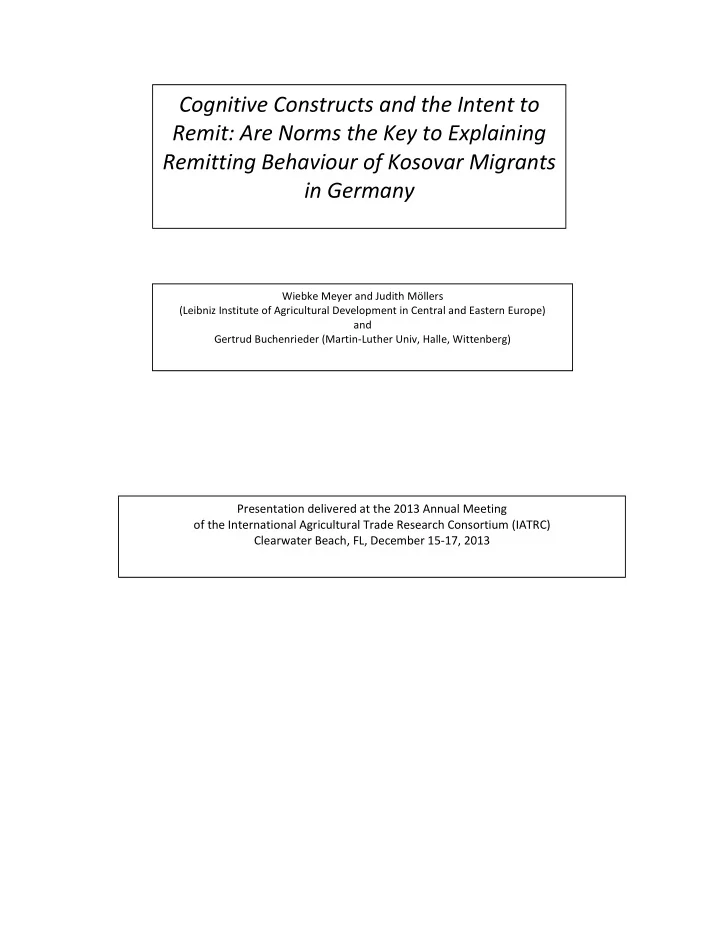

Cognitive Constructs and the Intent to Remit: Are Norms the Key to Explaining Remitting Behaviour of Kosovar Migrants in Germany Wiebke Meyer and Judith Möllers (Leibniz Institute of Agricultural Development in Central and Eastern Europe) and Gertrud Buchenrieder (Martin-Luther Univ, Halle, Wittenberg) Presentation delivered at the 2013 Annual Meeting of the International Agricultural Trade Research Consortium (IATRC) Clearwater Beach, FL, December 15-17, 2013
Cognitive constructs and the intention to remit Are norms the key to explaining remitting behaviour of Kosovar migrants in Germany? W. Meyer, J. Möllers, and G. Buchenrieder Judith Möllers IACTR conference 2013 | 14 – 17 December www.iamo.de 1
Importance of Remittances • 150 million migrants worldwide sent more than US$300 billion to developing countries • Remittances reach approximately 10% of the world’s population • Remitting is important on the micro & macro level Source: IFAD Introduction • What are the determinants of the remitting Theory decision? - Individual decision making as the Data & method PLS results level where migration is explained Conclusion www.iamo.de 2 2
Remittances & Kosovo • Long migration history & large diaspora • Among top 10 emigration countries • >20% of households engage in migration, 90% of migrants remit • Strong dependency on remittances: 705 million €, 18% of GDP; = > 8x ODA Introduction • Strong links to home country Theory Data & method maintained, even after about half of the PLS results diaspora has naturalised with the Conclusion destination countries www.iamo.de 3 3
Outline • Theoretical and empirical roots of remitting : – Motives for remitting (theory and empirical evidence) – Cognitive constructs: Theory of planned behaviour (TPB) • Survey design and method: – Recognising the ‘dyad of remitting’ – PLS modelling • Model results on motives for remitting: – A TPB-PLS model Introduction – Subjective norms in the focus Theory Data & method • Conclusions PLS results Conclusion www.iamo.de 4 4
Roots of remitting behaviour Theoretical motives for remitting (Rapoport and Docquier 2006) – Altruism, Exchange, Inheritance (individualistic motives) – Investment, Insurance (familial arrangements) Empirical roots of remitting behaviour (simplified from Carling 2008) Relation between migrant (household) and origin household Introduction Theory Data & method Migrant, in particular Origin household, in PLS results the financial capability particular the need for Conclusion of migrant to remit support www.iamo.de 5 5
Theory of planned behaviour (TPB) BEHAVIOURAL ATTITUDE BELIEFS NORMATIVE SUBJECTIVE BEHAVIOUR INTENTION BELIEFS NORMS Introduction Theory PERCIEVED CONTROL Data & method BEHAVIOURAL BELIEFS CONTROL PLS results Adapted from Ajzen 1991 Conclusion www.iamo.de 6 6
Survey design & data • Survey: 09/2009 and 04/2010, N=225 • Target groups: Albanian labour migrants + origin farm households = ‘Dyad of potential sender and receiver’ (Carling 2008) • Data: motivation triangle + TPB variables (Likert scales) Migrant household Origin household Introduction Theory Data & method • Demography • Demography • Income and capital endowment PLS results • Migration (history) • Living conditions at present in D and Conclusion • Income and living standard before migration • Farming and farm assets • Remittances and remitting behaviour • Non-farm employment strategies • Items for application of TPB www.iamo.de 7 7
Descriptives • Typical migrants: male, young, unmarried, unemployed or worked on the family farm before migration • Initial cost of migration: median 350 € (avg. 640€) • Networks matter, but finding work is no easy task • Almost all migrants remit (often transfer is in cash) • Annual remittances: 4000€ (median) ≈ 2 monthly incomes of migrant or ≈ a full median annual income of recipient household Introduction Theory • Financial possibilities of migrant & Data & method neediness of origin household matter PLS results Conclusion • High personal feeling of connectedness to Kosovo www.iamo.de 8 8
From TPB to PLS-SEM SOCIO- BEHAVIOURAL ATTITUDE ECONOMIC BELIEFS FACTORS NORMATIVE SUBJECTIVE INTENTION BELIEFS NORMS Introduction Theory Data & method PERCIEVED CONTROL PLS results BEHAVIOURAL BELIEFS Conclusion CONTROL Adapted from Ajzen 1991 www.iamo.de 9 9
PLS-SEM Model Introduction Theory Data & method PLS results Conclusion www.iamo.de 10 10
SEM results: norms construct POSITIVE SOCIO-ECON. BEHAVIOUR ATTITUDE FACTORS NEGATIVE AL BELIEFS 0.6 SOCIO-ECON. 0.4 0.1 FACTORS -0.2 0.3 NORMATIVE SUBJECTIVE NORMATIVE SUBJECTIVE BEHAVIOUR INTENTION BELIEFS NORMS BELIEFS NORMS 0.6 0.1 Introduction Theory Data & method PERCIEVED CONTROL BEHAVIOURAL PLS results BELIEFS CONTROL -0.5 Conclusion www.iamo.de 11 11
SEM results: norms constructs X parents most most my people Albanians relatives 0.3 people in 0.8 0.2 0.1 X 0.0 village NORMATIVE SUBJECTIVE 0.7 siblings BELIEFS NORMS Introduction 0.6 Theory 0.4 Data & method wife PLS results Conclusion www.iamo.de 12 12
Conclusions The behavioural perspective is relevant: Cognitive constructs increase the dimensionality of • remittances analysis • Attitudes , norms and perceived control contribute to explaining the intention to remit Migrant household Origin household • Strong family ties and high perceived expectations increase the intention to remit • Remittances are motivated by intrafamilial arrangements that are enforced by strong norms www.iamo.de 13 13
Recommend
More recommend